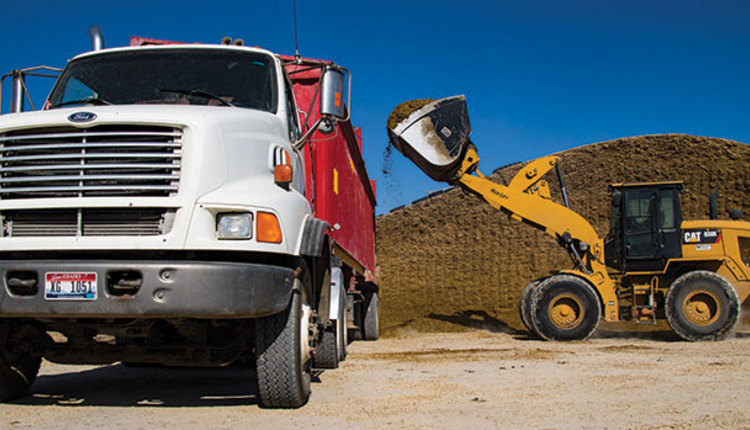
Silage shrink can cause silage to go from an economical source of feed to one that doesn’t make sense or cents. Shrink is the dry matter (DM) that is harvested but lost before feeding. In well-managed silage production, 10 to 20 percent shrink is typical. But up to 50 percent shrink can occur if some basic recommended practices aren’t followed.
Stop the shrink
Here are the keys to reducing your shrink losses:
Harvest at the right dry matter: Target 30 to 40 percent DM. Kernel milk stage cannot be relied upon to gauge optimal harvest timing, but it can be a useful indicator of when to begin measuring whole-plant DM content. For corn silage, 80 percent kernel milk marks the time to start testing. Under drought conditions, collect samples slightly earlier to ensure you don’t miss the window.
If the silage is too wet, you lose DM to seepage, and if it’s too dry you can’t pack it tight enough to eliminate air, losing DM to aerobic bacteria, mold, and yeast. Either way, when outside of the target window, shrink can literally eat your cow’s lunch!
Get it packed: Strive for a minimum packing density of 45 pounds per cubic foot (as fed). If storing in a bunker or pile, then you need 800 pounds of pack tractor weight per ton of silage per hour to get a good pack. You only want to be packing layers of 6 inches or less.
This is something that many cow-calf operations have issues with, especially if the silage is being custom cut. The rate of harvest may be too fast for the number and/or weight of the pack tractors. You may need to add weight to your tractor, or it may be the time to reach out to a neighbor and see if they can bring a tractor over during packing time so that you can keep up with the harvester. Shrink losses typically range from 5 to 10 percent due to improper packing.
Get it covered: You need to exclude air as quickly as possible, this means covering the top and, if using porous material such as bales for sides, then lining the sides with plastic film before filling. Covering bunkers or piles is a pain, but it’s worth it. Air can penetrate 3 feet into silage and cause losses. Use an oxygen barrier film, as this will reduce losses 3 to 5 percent over standard plastic.
Shrink typically ranges from 2 to 6 percent when covered right away, but an uncovered pile can result in 10 to 20 percent loss. As soon as possible means to get it done the same day; a week’s delay doubles the storage loss.
Would you rather pitch it or cover it?
You may be saying neither and just feed it. But feeding spoiled silage can have unintended consequences. Research from Kansas State University showed that including the “slimy” material at the surface of uncovered silage in the diet at just 5 percent of DM dropped intake by a pound per day and digestibility of the whole diet by 5 percent. This means that it essentially had no energy value as well as brought down the digestion of other feeds in the diet. They actually showed it affects the rumen environment, and thus the digestion of the other feeds in the diet.
Manage feedout: Target a minimum of 6 to 8 inches removed off the face per day, with 12 to 18 inches in the summer. Make sure you have sized your bunker or pile correctly. Most cow-calf operations have too wide of a face for their feedout rate. For 100 cows and
15 pounds DM per cow, the bunker face should only be about 20 feet wide by
12 feet high. Having the right-sized face can be extremely difficult to do with a pile, as the face (the surface exposed to air during feeding) can be very large. If you have a relatively low feedout rate, it may be worth considering bags.
Use the correct unloading technique: You want to keep the silage packed with the shortest amount of time between exposure to air and feeding as possible. Loose silage is the enemy as it allows mold and yeast to start devouring the feed. Proper unloading technique includes shaving silage down the face and never “digging” the bucket into the bottom of the silage face. Scrape with the bucket from top down. Undercutting creates an overhang of silage that can loosen and tumble to the floor. If your face is not tight and vertical, you are doing it wrong.
Check for heating by inserting your hand into the silage that you are loading into the total mixed ration or bunk. A general rule of thumb is that if it feels hot, you are burning money because all of the highly digestible parts are being eaten before you get it to the cattle. Losses due to face management typically range from 3 to 20 percent. Yes, 20 percent can occur with improper feedout techniques.
Every little bit helps
Many of the things listed above will save you 5 to 10 percentage units. It may be hard to grasp what 5 to 10 percent means, but to put it in perspective, that is between one to two loads of silage in every 20 that just disappears. Likely, if you don’t have the time to manage shrink, then you probably can’t afford to be making silage.
For more information on silage production, check out the videos from the Silage for Beef Cattle Conference at bit.ly/HFG-beefsilage.
This article appeared in the August/September 2018 issue of Hay & Forage Grower on page 20.
Not a subscriber? Click to get the print magazine

